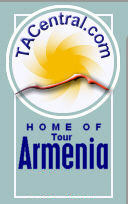The Armenians are an Indo-European race made up of tribes that long inhabited the Armenian Plateau. It is probably impossible to accurately pinpoint the predominant ethnic make-up of the people. The "pure" Armenian is considered Aryan in features with blonde hair and blue eyes, though one would be hard-pressed to find more than a small percentage with these pure features within the population. Many have an olive to dark complexion, with black or brown hair and eyes.
Research differs on the origins of the Armenian people, some suggesting that they are an amalgam of people who came together during the Urartian (Araratian) period, while others cite Herodotus and Strabo accounts' of the people migrating into the Armenian highlands from Thrace and Phyrgia around 2000 BC.
The highlands were populated as early as 2 million BC, with settlements rising in the Ararat valley as early as 9000 BC and centers for the smelting of copper and bronze rising as early as 5000 BC.
It is more likely that the Armenians are a compilation of all the peoples who rose and entered the area over waves of Indo-European exodus and the return from ca. 9000 BC through the 1st millennium BC.
By their language hints, it appears Armenians are more recently descended from the Hayasa-Azzi, Nairi, Hurrians and others. The predominant family seems to have evolved and made itself apparent by the mid 1st millennium BC. For immediately following the collapse of the Urartian Empire, the Armenians appeared in history as a unified people.
For more details on Armenian orgins, see History
Tribes
Tribes formed the essence of the Armenian culture from its inception, and to some, it continues to cause challenges. The greatest part of Armenia's history revolves around threat of invasion and in-fighting among ruling families. Bagratunis, Artsruni's, Proshians, Orbelians, Arshakids and Diaspora communities can be a divided and fractious group. One thing becomes clear to anyone who visits long enough: there is a clear division between Western and Eastern Armenians, who led decidedly different lives following the first Diaspora. This intensified after the genocide of 1915-1918, when Soviet Armenia was cut-off from the outside world, and Armenian communities grew in Syria, Lebanon, Iraq, Iran, Egypt, Europe and the Americas, among other countries. Western Armenian is a different dialect from Eastern, and we have more than once heard a member of one side wax poetic about the glories of "their" language while casting dispersions on the other side.
The differences are more than language, though, as Western Armenians struggle to come to grips with their brethren in the Republic, who likewise struggle to grasp the 'new' Armenian world on the outside. Further divisions are drawn between Lebanese Armenians, Syrian Armenians, Iranian (or Persian) Armenians, Iraqi Armenians and those living in Europe. While Armenians pride themselves on being a cohesive unit, in reality there are prejudices places against Armenians based on where they live. Armenians will subdivide themselves as "Syrian Armenians", "Beirut Armenians", Iraqi Armenians" "Persian (Iranian) Armenians", "French Armenians", with "Los Angeles Armenian" (Or 'Los Armenios') being both one of the most envied and misunderstood group of all.
At times this leads to deep dissension and bitterness between populations, especially at the current time, when Eastern Armenians are suspicious of the motives Diaspora Armenians have when they conduct business or lend assistance to the Republic. It is a slow and painful process, and it heightens tensions between groups, while they remain fiercely cohesive on the essential right of Armenians to exist in a peaceful world.
Ancient sub-tribes included the Zok, who spoke a different language from the Indo-European Armenian. The Zok predominantly lived in Nakhijevan, their capital was Akuli. The Zok are reputed to have developed the Armenian culture in Tbilisi. Aram Khachaturian was a Zok Armenian. Other distinct subgroups in Armenia are the Armenians of Nagorno Karabakh, the region of Siunik and Vayots Dzor, Sevan, Northern Armenia and the Armenians from Western Armenia. There are countless other sub-tribes, and for those interested in genealogy, contact the Armenian Genealogical Society.
Name Origins
A "marker" of old regional differences are name endings. The common suffix ending '-iantz' and -'ountz' is said to have originated in the South of Old Armenia, denoting "part of" or "belonging to" (as in Gevorgiantz meaning "part of Gevorg" or "belonging to Gevorg"). The suffix '-uni' (as in Bagratuni) is said to have denoted aristocratic origins by some, while other dispute that theory. Reliably is it known to have denoted a place of origin, as was the suffix "-atsi". One needs to bear in mind that common people did not have a last name in centuries past, and each man was known by his given name, and if need be, the place he came from. Movses Khorenatsi could be translated Movses of Khoren, or Movse, belonging to Khoren. The term also meant "son of". In some areas, daughters were given their father's name with an '-doukht", "-doush", "-noush" or "-touhi", all meaning "daughter of". In this way, the Armenian family names have use the same system as Europeans.
The most common ending is -ian, and we have heard several reasons for this, the most plausible being it denotes "son of" or "from". Hence Torossian could be translated to mean "son of Toros" or "from Toros.
In 1997, genetic scientists uncovered a "marker" gene, which may prove a common ancestry between Armenians, Ashkenazi Jews and Semitic Arabs. The gene is shared only by these ethnic groups, and indicates a very old and common origin.




